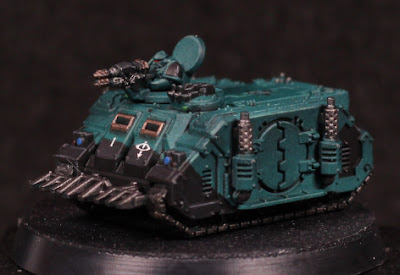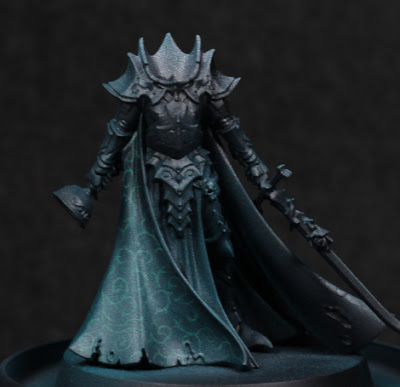 |
| "Storm of Silence", or maybe "Silent, but deadly." |
Another model that has been sitting in the pile for a while is the relatively recent Phoenix Lord of the Howling Banshees: Jain Zar, the Storm of Silence. I really like the sculpt, a refresh of which was sorely needed compared to the old one. This new version is an even more dynamic pose and really sells this idea of a dancing whirlwind of blades, graceful but with terrible purpose. To do that, the sculptor obviously wasn't going for inredible realism, not with that amount of hair - and I think that's best. This is a model, meant to capture the feeling a particular character and their traits rather than be an accurate depiction of their physical form. That's always been the case for Games Workshop, but I think this model captures the idea particularly well and I've been thinking how to paint it for quite some time. I will state that I did not, and do not, intend to paint this model to the same technical level as Azrakh. That model was for learning more than anything else, and this one I want to play more with the overall composition of light and colour.
Originally I had intended to paint the armour in a similar bone pattern to the Avatar of Khaine, but when I came to it, it just didn't seem to fit. The armour has hardened surfaces, but don't really look like additional pieces compared to the rest of the bodysuit - more like they're part of it, not overlaid. Something rigid like bone wouldn't do.
Looking back at the original model there are blues and violets, which is when I was struck by an odd piece of inspiration from the background story. Jain Zar existed before the Fall of the Aeldari, and was apparently part of a precursor to Drukhari - which traditionally are painted with a hefty amount of purple. The particular power in the warp that spawned from the downfall of the Aeldari is also often painted with purples, violets, and burgundy. It occurred to me that this probably came from colours of the Eldar civilisation - and so the armour of Jain Zar might have a nod to that.
To start with the colours, the blade isn't final. That was simply messing about with blues on the palette, and I intend to paint over it later - although I do like the idea of a blue hint to the blade. The hair I had also airbrushed first, using some purples and whites in very thin layers to build up the volumes...and then promptly ruined the lot by using Black Templar over the whole thing. I thought it was thinned enough, but everything just went black again afterwards. Oops.
The main armour is a combination of six paints, however only three of them are really needed. I used six because I wanted to get a feel of the paints, not for any transition reasons, and I did blend between all of them on the palette quite a lot. The closer a paint comes to white, the more difficult I find it to glaze and blend with other colours, and it took quite a while to get this far. I also tried to avoid very strong value contrasts between "panels" and "garment" - I wanted to give an impression of a hardened surface that is also part of the more flexible material, and softening the edge transitions can help do that. The colours used are:
- Barak-Nar Burgundy, mostly in shadowed areas.
- Daemonette Hide.
- Warpfiend Grey.
- Slaanesh Grey.
- Ionrach Skin.
- Deepkin Flesh.
If I were to choose only three, I'd go for Barak-Nar Burgundy, Daemonette Hide, and Ionrach Skin. Those were the colours used the most, and mixing to various degrees between them can give close approximations to the others.
The lighter areas are the right breast, right side of the face, and right arm. I imagined the light coming from the weapon, or close by it, fading towards darker colours on the opposite side and towards her feet. This would naturally draw the eye to upper chest, and I'm hoping a spot of colour on the mask will draw attention more directly to the facial area. I've yet to decide on which colour for the eyes - red, blue, or teal. The vambrace and and other more obvious armoured parts I'm intending to borrow from something done on Azrakh by making them "shiny black" rather than silver, with a little Dark Reaper just to add interest (I'll probably using Thunderhawk Blue to highlight that just a little more later on). I'd considered using metallic paints, but that somehow doesn't gel with the concept of the Aeldari using Wraithbone for their manufacturing, and the shiny surface would almost certainly detract away from everything else. So in this case, using NMM techniques again seems appropriate.
I've used Barak-Nar Burgundy as the base colour for cloth, weapon grips, etc, merely as a colour sketch at this stage. I'll probably go for reds on the spirit stones, maybe a blue here or there, and the burgundy seemed appropriate as a starting point. I don't want a bright red, so I'll see where this takes me.
The base came about almost by accident. While I didn't want bone coloured armour on Jain Zar, it did seem suitable for the ruins of some ancient shrine perhaps. Morghast Bone, Seraphim Sepia, Skeleton Horde, and Screaming Skull. Actually Seraphim Sepia looks very much similar to Skeleton Horde, with the paint consistency more the different than anything else. While doing that I realised that it was a good value contrast to Jain Zar; she is using darker tones overall, and so a brighter and more colourful base might serve as a good contrast to that. I also reasoned that perhaps the ruins are from a time long past, maybe on a world that is now quiet from the echoes of past wars - or in other words, plants have started to grow on it. This would add a splash of colour and visual interest, and as a bonus needs no sculpting from me. I also conveniently recently was gifted some "flowers" that I wanted to try out. Between those, some grass tufts, and a small amount of flock glued in place, the base turned out alright. It needs a bit of tidying up still, and a few overhanging parts could be trimmed back, but I think overall it serves the purpose I intended.
I'm not sure where to go with the hair next. I want it to read as black hair, but some volume highlighting needs to be done. Perhaps a light "dampbrush" with a mostly desaturated violet, followed up with Nuln Oil to bring it back and better define some areas. I'll consider further as I get more of the armour completed.
-- silly painter.






























